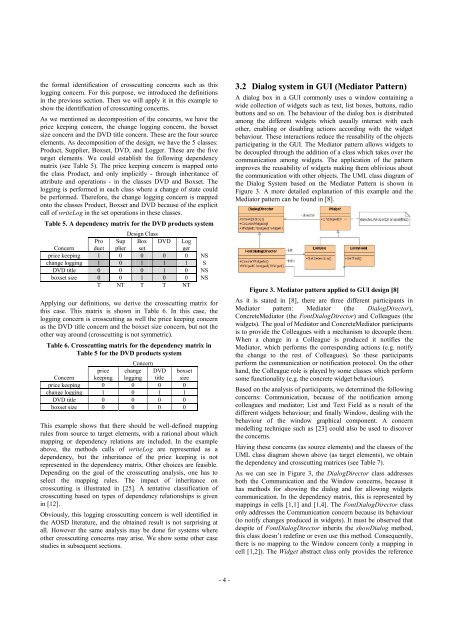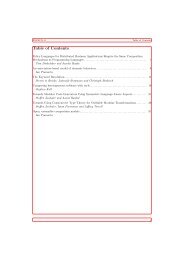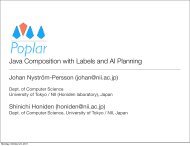Identification of Crosscutting in Software Design - ResearchGate
Identification of Crosscutting in Software Design - ResearchGate
Identification of Crosscutting in Software Design - ResearchGate
You also want an ePaper? Increase the reach of your titles
YUMPU automatically turns print PDFs into web optimized ePapers that Google loves.
the formal identification <strong>of</strong> crosscutt<strong>in</strong>g concerns such as this<br />
logg<strong>in</strong>g concern. For this purpose, we <strong>in</strong>troduced the def<strong>in</strong>itions<br />
<strong>in</strong> the previous section. Then we will apply it <strong>in</strong> this example to<br />
show the identification <strong>of</strong> crosscutt<strong>in</strong>g concerns.<br />
As we mentioned as decomposition <strong>of</strong> the concerns, we have the<br />
price keep<strong>in</strong>g concern, the change logg<strong>in</strong>g concern, the boxset<br />
size concern and the DVD title concern. These are the four source<br />
elements. As decomposition <strong>of</strong> the design, we have the 5 classes:<br />
Product, Supplier, Boxset, DVD, and Logger. These are the five<br />
target elements. We could establish the follow<strong>in</strong>g dependency<br />
matrix (see Table 5). The price keep<strong>in</strong>g concern is mapped onto<br />
the class Product, and only implicitly - through <strong>in</strong>heritance <strong>of</strong><br />
attribute and operations - <strong>in</strong> the classes DVD and Boxset. The<br />
logg<strong>in</strong>g is performed <strong>in</strong> each class where a change <strong>of</strong> state could<br />
be performed. Therefore, the change logg<strong>in</strong>g concern is mapped<br />
onto the classes Product, Boxset and DVD because <strong>of</strong> the explicit<br />
call <strong>of</strong> writeLog <strong>in</strong> the set operations <strong>in</strong> these classes.<br />
Table 5. A dependency matrix for the DVD products system<br />
<strong>Design</strong> Class<br />
Pro Sup Box DVD Log<br />
Concern duct plier set<br />
ger<br />
price keep<strong>in</strong>g 1 0 0 0 0 NS<br />
change logg<strong>in</strong>g 1 0 1 1 1 S<br />
DVD title 0 0 0 1 0 NS<br />
boxset size 0 0 1 0 0 NS<br />
T NT T T NT<br />
Apply<strong>in</strong>g our def<strong>in</strong>itions, we derive the crosscutt<strong>in</strong>g matrix for<br />
this case. This matrix is shown <strong>in</strong> Table 6. In this case, the<br />
logg<strong>in</strong>g concern is crosscutt<strong>in</strong>g as well the price keep<strong>in</strong>g concern<br />
as the DVD title concern and the boxset size concern, but not the<br />
other way around (crosscutt<strong>in</strong>g is not symmetric).<br />
Table 6. <strong>Crosscutt<strong>in</strong>g</strong> matrix for the dependency matrix <strong>in</strong><br />
Table 5 for the DVD products system<br />
Concern<br />
Concern<br />
price<br />
keep<strong>in</strong>g<br />
change<br />
logg<strong>in</strong>g<br />
DVD<br />
title<br />
boxset<br />
size<br />
price keep<strong>in</strong>g 0 0 0 0<br />
change logg<strong>in</strong>g 1 0 1 1<br />
DVD title 0 0 0 0<br />
boxset size 0 0 0 0<br />
This example shows that there should be well-def<strong>in</strong>ed mapp<strong>in</strong>g<br />
rules from source to target elements, with a rational about which<br />
mapp<strong>in</strong>g or dependency relations are <strong>in</strong>cluded. In the example<br />
above, the methods calls <strong>of</strong> writeLog are represented as a<br />
dependency, but the <strong>in</strong>heritance <strong>of</strong> the price keep<strong>in</strong>g is not<br />
represented <strong>in</strong> the dependency matrix. Other choices are feasible.<br />
Depend<strong>in</strong>g on the goal <strong>of</strong> the crosscutt<strong>in</strong>g analysis, one has to<br />
select the mapp<strong>in</strong>g rules. The impact <strong>of</strong> <strong>in</strong>heritance on<br />
crosscutt<strong>in</strong>g is illustrated <strong>in</strong> [25]. A tentative classification <strong>of</strong><br />
crosscutt<strong>in</strong>g based on types <strong>of</strong> dependency relationships is given<br />
<strong>in</strong> [12].<br />
Obviously, this logg<strong>in</strong>g crosscutt<strong>in</strong>g concern is well identified <strong>in</strong><br />
the AOSD literature, and the obta<strong>in</strong>ed result is not surpris<strong>in</strong>g at<br />
all. However the same analysis may be done for systems where<br />
other crosscutt<strong>in</strong>g concerns may arise. We show some other case<br />
studies <strong>in</strong> subsequent sections.<br />
3.2 Dialog system <strong>in</strong> GUI (Mediator Pattern)<br />
A dialog box <strong>in</strong> a GUI commonly uses a w<strong>in</strong>dow conta<strong>in</strong><strong>in</strong>g a<br />
wide collection <strong>of</strong> widgets such as text, list boxes, buttons, radio<br />
buttons and so on. The behaviour <strong>of</strong> the dialog box is distributed<br />
among the different widgets which usually <strong>in</strong>teract with each<br />
other, enabl<strong>in</strong>g or disabl<strong>in</strong>g actions accord<strong>in</strong>g with the widget<br />
behaviour. These <strong>in</strong>teractions reduce the reusability <strong>of</strong> the objects<br />
participat<strong>in</strong>g <strong>in</strong> the GUI. The Mediator pattern allows widgets to<br />
be decoupled through the addition <strong>of</strong> a class which takes over the<br />
communication among widgets. The application <strong>of</strong> the pattern<br />
improves the reusability <strong>of</strong> widgets mak<strong>in</strong>g them oblivious about<br />
the communication with other objects. The UML class diagram <strong>of</strong><br />
the Dialog System based on the Mediator Pattern is shown <strong>in</strong><br />
Figure 3. A more detailed explanation <strong>of</strong> this example and the<br />
Mediator pattern can be found <strong>in</strong> [8].<br />
Figure 3. Mediator pattern applied to GUI design [8]<br />
As it is stated <strong>in</strong> [8], there are three different participants <strong>in</strong><br />
Mediator pattern: Mediator (the DialogDirector),<br />
ConcreteMediator (the FontDialogDirector) and Colleagues (the<br />
widgets). The goal <strong>of</strong> Mediator and ConcreteMediator participants<br />
is to provide the Colleagues with a mechanism to decouple them.<br />
When a change <strong>in</strong> a Colleague is produced it notifies the<br />
Mediator, which performs the correspond<strong>in</strong>g actions (e.g. notify<br />
the change to the rest <strong>of</strong> Colleagues). So these participants<br />
perform the communication or notification protocol. On the other<br />
hand, the Colleague role is played by some classes which perform<br />
some functionality (e.g. the concrete widget behaviour).<br />
Based on the analysis <strong>of</strong> participants, we determ<strong>in</strong>ed the follow<strong>in</strong>g<br />
concerns: Communication, because <strong>of</strong> the notification among<br />
colleagues and mediator; List and Text Field as a result <strong>of</strong> the<br />
different widgets behaviour; and f<strong>in</strong>ally W<strong>in</strong>dow, deal<strong>in</strong>g with the<br />
behaviour <strong>of</strong> the w<strong>in</strong>dow graphical component. A concern<br />
modell<strong>in</strong>g technique such as [23] could also be used to discover<br />
the concerns.<br />
Hav<strong>in</strong>g these concerns (as source elements) and the classes <strong>of</strong> the<br />
UML class diagram shown above (as target elements), we obta<strong>in</strong><br />
the dependency and crosscutt<strong>in</strong>g matrices (see Table 7).<br />
As we can see <strong>in</strong> Figure 3, the DialogDirector class addresses<br />
both the Communication and the W<strong>in</strong>dow concerns, because it<br />
has methods for show<strong>in</strong>g the dialog and for allow<strong>in</strong>g widgets<br />
communication. In the dependency matrix, this is represented by<br />
mapp<strong>in</strong>gs <strong>in</strong> cells [1,1] and [1,4]. The FontDialogDirector class<br />
only addresses the Communication concern because its behaviour<br />
(to notify changes produced <strong>in</strong> widgets). It must be observed that<br />
despite <strong>of</strong> FontDialogDirector <strong>in</strong>herits the showDialog method,<br />
this class doesn’t redef<strong>in</strong>e or even use this method. Consequently,<br />
there is no mapp<strong>in</strong>g to the W<strong>in</strong>dow concern (only a mapp<strong>in</strong>g <strong>in</strong><br />
cell [1,2]). The Widget abstract class only provides the reference<br />
- 4 -




